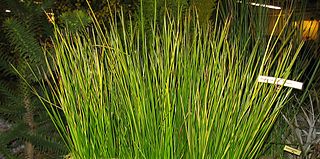
Baumea is a genus of the sedge family, which includes around 30 species native to Madagascar and the Pacific Islands, with 15 species in Australia. All are perennial rhizomatous herbs, with leaves and stems very similar in appearance. The inflorescence is terminal, with the flowers tightly clustered or loosely arranged. The fruits are small nuts.
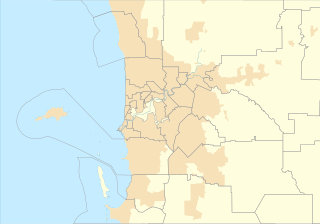
Thomsons Lake Nature Reserve is a lake nature reserve around Thomsons Lake in the City of Cockburn, Western Australia, approximately 25 kilometres (16 mi) south of the central business district of Perth, the state capital, and on the southern fringes of the Perth metropolitan area. It is in the suburb of Beeliar, 7 kilometres (4.3 mi) south-west of Jandakot Airport. It is a still largely natural wetland, with adjoining native vegetation, surrounded by land developed for housing and agriculture, that regularly supports large numbers of shorebirds and other waterbirds.
Taylor Inlet is an inlet located in the Great Southern region of Western Australia. The inlet is located on the coast near Nanarup Beach and is approximately 23 kilometres (14 mi) East of Albany and is contained within the Taylor Inlet nature reserve.

The Discovery Bay Coastal Park is a linear protected area of coastal land in western Victoria, south-eastern Australia. The 10,460-hectare (25,800-acre) park extends along the coast of Discovery Bay from Cape Nelson north-westwards for 50 kilometres (31 mi) to the border with South Australia. The park was listed on Australia's now-defunct Register of the National Estate, and lies within the traditional lands of the Gunditjmara people.
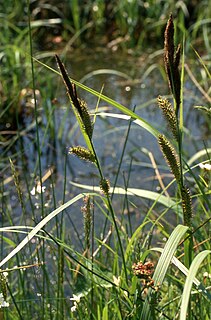
Carex riparia, the greater pond sedge, is a species of sedge found across Europe and Asia. It grows in a variety of wet habitats, and can be a dominant species in some swamps. It is Britain's largest Carex, growing up to 130 cm tall, with glaucous leaves up to 160 cm long. It hybridises with a number of other Carex species, including the closely related Carex acutiformis – the lesser pond sedge. A variegated cultivar is grown as an ornamental grass.
The Interlaken Lakeside Reserve is a wetland reserve at subalpine Interlaken, lying at the north-western end of Lake Crescent on the Interlaken isthmus between the reservoirs of Lakes Sorell and Crescent, about 20 km west of Tunbridge, in the Central Highlands of Tasmania, Australia. In 1982 it was designated a wetland of international importance under the Ramsar Convention.
Hollandaea riparia, sometimes named roaring Meg hollandaea, is a species of Australian rainforest tree, in the plant family Proteaceae.

Lake Barracoota is a naturally forming permanent freshwater lake located in the East Gippsland region in the Australian state of Victoria. The lake is located entirely within the Croajingolong National Park and when full, the surface area of the lake is 240 hectares.

Shark Lake is a freshwater lake in the Goldfields-Esperance region of Western Australia approximately 13 kilometres (8 mi) north of Esperance.

Baumea acuta, commonly known as pale twig-rush, is a flowering plant in the sedge family, Cyperaceae, that is native to southern parts of Australia.
Baumea arthrophylla is a flowering plant in the sedge family, Cyperaceae that is native to Western Australia.
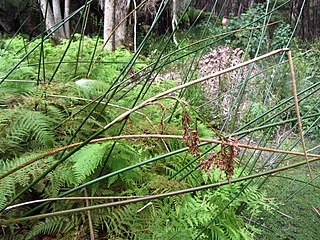
Baumea articulata, commonly known as jointed rush, is a sedge in the sedge family, Cyperaceae, that is native to Western Australia. The grass-like plant is rhizomatous and perennial, it typically grows to a height of 1 to 2.6 metres. It blooms between September and December producing red-brown flowers on pendulous inflorescences.

Machaerina juncea, commonly known as bare twig-rush or tussock swamp twig rush, is a sedge in the sedge family, Cyperaceae, that is native to Australia, New Zealand, and New Caledonia.
Baumea laxa is a flowering plant in the sedge family, Cyperaceae, that is native to Western Australia.
Baumea preissii is a flowering plant in the sedge family Cyperaceae, which is native to Western Australia.

Machaerina rubiginosa, commonly known as soft twig rush, flat leaf twig rush or common twig rush, is a flowering plant in the sedge family, Cyperaceae, that is native to Asia and the Pacific.
Baumea vaginalis, commonly known as sheath twig rush, is a flowering plant in the sedge family, Cyperaceae, that is native to Western Australia.
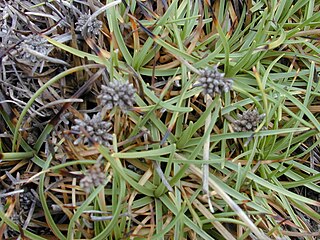
Fimbristylis cymosa, commonly known as tropical fimbry, or St. John's sedge, is a sedge of the family Cyperaceae that is native to Australia.

Lake Hawdon South Conservation Park is a protected area located in the Australian state of South Australia in the locality of Bray about 280 kilometres (170 mi) south-east of the state capital of Adelaide and about 18 kilometres (11 mi) east of the town of Robe.










